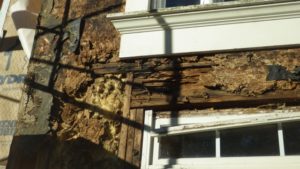
When choosing a home, the risk of hidden damage and potential for high maintenance costs down the road should always factor into your purchasing decision. One of the first places to look is in the building materials used; certain materials like stucco can disguise significant damage and be difficult to detect and repair.
Stucco rose to popularity as a building product in the mid to late 90’s and was used often through the mid 2000’s and is a great siding material when you consider longevity, durability and general maintenance. However, when installed incorrectly, stucco becomes vulnerable around windows and doors and can allow water to slowly seep behind the surface, causing rot, decay and potential structural issues, including termite damage.
In a humid climate that gets a decent amount of rain, the Delaware Valley area can be a bit notorious for homes with stucco damage and anyone who has dealt with stucco damage knows that it isn’t always a cheap fix. Some repairs can cost a couple of thousand dollars and major issues can cost tens of thousands of dollars to take down the old stucco, replace rotted wood and other issues and then reapply new underlayment and new stucco.
If you are buying or selling a home that was built more recently, there is a good chance that most of the notorious issues from years past were corrected with new installation methods and materials, and that there is little to no damage to the home in question.
If you are a buyer and are interested in a stucco home built during the 90’s through the mid 2000’s, it is in your best interest to insist on getting some tests done on the home to help ensure that there is no damage.
Types of Inspections
In addition to visual inspections where an inspector can look for obvious signs of rot, there are other methods of testing which you may want to consider.
- There are surface scanners which can be run over the exterior surface of the home to check moisture levels. This method is easy to do, leaves no damage to the walls but is not entirely accurate or definitive.
- Invasive testing: This is where holes are drilled either in the interior or exterior where damage is likely. A moisture detector is fished into the holes and a reading is taken to determine if the moisture level is high enough to confirm that water is breaching the stucco.
- There are also infrared cameras that can scan a home and look for temperature differences within a stucco wall. Due to water evaporation, the areas where moisture is high will read cooler than dry areas. While this doesn’t necessarily confirm the presence of moisture, the process can aid in determining where invasive testing should take place by using the infrared scan as a guide.

By getting one or more of these styles of tests done, you can better protect yourself by decreasing the chance that costly repairs aren’t in your future and that the presence of mold or other issues likely do not exist in your living space.
If you are a seller, it is equally important that you get your home tested and clear any potential issues before you put your house on the market. By getting any identifiable issues out of the way, you put potential buyers at ease and the process of selling your home isn’t delayed by additional testing or repairs if they are required.
Whoever is ordering the repair should document any project to prove that inspections took place, repairs were made to any impacted part of the home and that the correct methods were used to make those repairs. This documentation will serve you well down the road when the house is up for sale again in the future.
Class-Harlan Real Estate prides itself on paying attention to considerations like stucco in real estate transactions. They will work for the benefit of their buyers or sellers in helping them make informed decisions before a real estate transaction.
If you are interested in a home that has stucco siding, Class-Harlan can source knowledgeable and reputable inspectors and contractors to make sure that any issues are detected and subsequently dealt with in the proper manner.
Give us a call today and speak with one of our expert realtors today.
